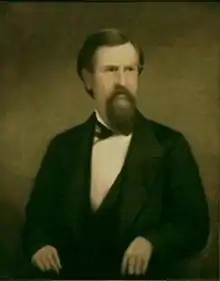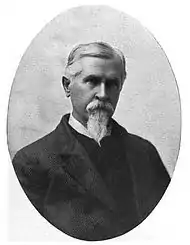James D. Porter
James Davis Porter (December 7, 1828 – May 18, 1912) was an American attorney, politician, educator, and officer of the Confederate Army. He served as the 20th Governor of Tennessee from 1875 to 1879. He was subsequently appointed as Assistant Secretary of State during President Grover Cleveland's first administration, and Minister to Chile in Cleveland's second administration.
James Davis Porter | |
|---|---|
 Portrait of Porter by Washington B. Cooper | |
| 20th Governor of Tennessee | |
| In office January 18, 1875 – February 16, 1879 | |
| Preceded by | John C. Brown |
| Succeeded by | Albert S. Marks |
| United States Assistant Secretary of State | |
| In office March 20, 1885 – September 17, 1887 | |
| President | Grover Cleveland |
| Preceded by | John Davis |
| Succeeded by | George L. Rives |
| United States Minister to Chile | |
| In office July 4, 1893 – March 14, 1894 | |
| President | Grover Cleveland |
| Preceded by | Patrick Egan |
| Succeeded by | Edward H. Strobel |
| Member of the Tennessee House of Representatives | |
| In office 1859–1861 | |
| Personal details | |
| Born | December 7, 1828 Paris, Tennessee |
| Died | May 18, 1912 (aged 83) Paris, Tennessee |
| Resting place | Paris City Cemetery |
| Political party | Whig Democratic |
| Spouse | Susannah Dunlap (m. 1851) |
| Profession | Attorney, educator |
| Signature | |
| Military service | |
| Allegiance | |
| Branch/service | |
| Years of service | 1861–1865 |
| Rank | |
| Battles/wars | American Civil War • Belmont (1861) • Shiloh (1862) • Chickamauga (1863) • Missionary Ridge (1863) • Atlanta Campaign (1864) • Nashville (1864) |
As an elected state legislator on the eve of the Civil War, Porter had introduced the "Porter resolutions," which bound Tennessee to the Confederacy should war be declared. He served during much of the war as chief of staff to Confederate General Benjamin F. Cheatham, and saw action at various battles in Tennessee and Georgia.[1]
Porter spent his later years as chancellor of his alma mater, the University of Nashville, and as president of Peabody College. This was established at the University of Nashville during his gubernatorial administration. He oversaw the liquidation and transfer of the University of Nashville's assets to the Peabody Education Fund, which allowed Peabody College to be re-established near Vanderbilt University in 1909.[1]
Early life
Porter was born in Paris, Tennessee, the son of Dr. Thomas Kennedy Porter and Geraldine (Horton) Porter.[2] Their town was the county seat of Henry County, included within West Tennessee. Porter attended college at the University of Nashville, where he obtained a Bachelor of Arts in 1846, and a Master of Arts in 1849.[3] He studied law at Cumberland University and in Paris under local attorney John H. Dunlap; he was admitted to the bar in 1851.[4][5] That year he also married Susannah Dunlap, his mentor's daughter, starting his career and adult life.
Career and Civil War
Porter began a private practice in Paris, where he also became involved in politics. He was elected as a Whig to the Tennessee House of Representatives in 1859. In 1861, he introduced the "Porter resolutions," which were eventually adopted. These resolutions stipulated that, in the event of war between seceding states and the Union, Tennessee would align with the seceding states.[3] In early May 1861, following the Battle of Fort Sumter, these measures were enacted, and Tennessee signed a military pact with the Confederacy.
Porter was commissioned as an adjutant general under Gideon J. Pillow, and helped organize the Provisional Army of Tennessee.[3] After this army was attached to the greater Confederate Army, Porter was assigned to General Benjamin F. Cheatham. As Cheatham's chief of staff, Porter took part in the battles of Belmont, Shiloh, Chickamauga, Missionary Ridge, and the Siege of Atlanta.[6]
After the war, Porter returned to his law practice in Paris. In 1870, he was a delegate to the state's constitutional convention, which wrote the current Tennessee State Constitution, and served on the convention's judiciary committee.[6] Following the convention, he was elected judge of the state's 12th circuit.[2] Originally a Whig, he joined the Democratic Party after the Civil War, which was the party of the majority of southern whites.[7]
Governor
Porter received the Democratic nomination for governor in 1874. He easily defeated his Republican opponent, Horace Maynard, by a 105,061 to 55,847 vote later that year.[7] In 1876, he was reelected by a similarly lopsided margin over several candidates, among them moderate Democrat Dorsey B. Thomas and Republican William F. Yardley, the latter being the state's first African-American candidate for governor.[7][8]
Like his predecessor, John C. Brown, Porter spent much of his gubernatorial tenure managing the state's out-of-control debt. After the state defaulted on its bonded debt in 1875, Porter continued to argue that the state should pay off the bonds in full to protect its credit. The Panic of 1873 had greatly reduced tax revenues, however, and full repayment proved unfeasible. His successors sought only a partial repayment.[7]
Porter was a strong supporter of public education. When the Peabody Fund announced it was going to establish a school for teachers in Nashville, Porter used his influence to have the school attached to the University of Nashville.[7]
During his tenure, but independent of the state, the South's first medical school for African Americans, the privately supported Meharry Medical College, was founded in Nashville as part of Central Tennessee College, a historically black college founded by the northern Methodist Church.
Porter signed the so-called "Four Mile Law," an early, backdoor form of Prohibition that forbade alcoholic beverages within four miles (6.4 km) of any school.[7] Given the small size of most of the schools of the era, they were built in nearly every community, even many of the smallest ones. The law effectively outlawed alcohol in all but the least-populated areas of the state.
Later endeavors


In his book Appalachian Aspirations, Professor John Benhart describes Porter (and ex-Governor John C. Brown) as "typical of the New South Conservatives who dominated Tennessee politics during the two decades following Reconstruction, mixing the mores of the Old South with a recognition that industrial capitalism was the wave of the future."[9] Following his tenure as governor, Porter remained active in the New South economy.
He succeeded Edmund William Cole as the president of the Nashville, Chattanooga and St. Louis Railway from 1880 to 1884.[1][10] He also served on the board of directors of the Tennessee Coal, Iron and Railroad Company.[9]
In 1885, Porter was appointed Assistant Secretary of State by President Grover Cleveland. He served under Secretary of State Thomas F. Bayard. In 1893, during Cleveland's second term, Porter was appointed as U.S. Minister to Chile.[1] He served there until a change in administrations in the Spring of 1894.
Porter spent the latter part of his life promoting and raising funds for his alma mater, the University of Nashville (from which he had been granted an honorary LL.D. in 1877), and its affiliated Peabody College. He was appointed a trustee of the Peabody Education Fund in 1883, and became president of the Board of Trustees for the University of Nashville in 1890.[3]
Porter became chancellor of the University of Nashville in 1901, and president of Peabody College in 1902.[1] He supported the construction of Confederate Memorial Hall.[11] In the latter part of the decade, he oversaw the liquidation of the University of Nashville's assets and their transfer to the Peabody fund for the reestablishment of Peabody College. The fund chose to locate the reorganized college at Vanderbilt's campus, however, leaving Porter embittered.[1] He resigned from the fund's board in 1909.[1]
In 1899, Porter published a book, The Military History of Tennessee, War of 1861-65, which became Volume VIII of Clement Evans's 12-volume series, Confederate Military History. He was also active in the Tennessee Historical Society, at one point serving as its president.[1]
Porter died in 1912, and is buried in the Paris City Cemetery.[12]
Family
In 1851 Porter married Susannah Dunlap in Paris, Tennessee. She was the daughter of his law mentor, John H. Dunlap. They had six children together, three of whom died at a young age.[7]
References
- Christopher Losson, "James Davis Porter," Tennessee Encyclopedia of History and Culture, 2009. Retrieved: 1 November 2012.
- Finding Aid for Governor James D. Porter Papers Archived 2013-07-12 at the Wayback Machine, Tennessee State Library and Archives, 1964. Retrieved: 1 November 2012.
- Rossiter Johnson, The Twentieth Century Biographical Dictionary of Notable Americans, Vol. VIII (Boston: The Biographical Society, 1904).
- The Twentieth Century Biographical Dictionary of Notable Americans ... Biographical Society. 1904.
- "Collection: James D. Porter Papers | Collection Guides". collections.library.vanderbilt.edu. Retrieved 2022-01-31.
- Presidents of Peabody College: James Davis Porter Archived 2010-06-13 at the Wayback Machine, Jean and Alexander Heard Library Special Collections and University Archives, 12 September 2012. Originally published in The Peabody Record, October 1901. Retrieved: 1 November 2012.
- Phillip Langsdon, Tennessee: A Political History (Franklin, Tenn.: Hillsboro Press, 2000), pp. 198-203.
- Lewis Laska, William F. Yardley, Tennessee Encyclopedia of History and Culture, 2009. Retrieved: 1 November 2012.
- John Benhart, Appalachian Aspirations: The Geography of Urbanization and Development in the Upper Tennessee River Valley, 1865-1900 (Knoxville, Tenn.: University of Tennessee Press, 2007), p. 31.
- Burt, Jesse C., Jr. (June 1950). "Four Decades of the Nashville, Chattanooga & St. Louis Railway, 1873-1916". Tennessee Historical Quarterly. 9 (2): 99–130. JSTOR 42621038.
{{cite journal}}: CS1 maint: multiple names: authors list (link) - Simpson, John A. (2003). Edith D. Pope and Her Nashville Friends: Guardians of the Lost Cause in the Confederate Veteran. Knoxville, Tennessee: University of Tennessee Press. p. 102. ISBN 9781572332119. OCLC 750779185.
- Spencer, Thomas (1998). Where They're Buried: A Directory Containing More Than Twenty Thousand Names of Notable Persons Buried in American Cemeteries, with Listings of Many Prominent People who Were Cremated. Genealogical Publishing Company. p. 436. ISBN 9780806348230.
External links
- Confederate Military History Volume VIII: Tennessee – Porter's book on the Civil War in Tennessee
- John Henry Dunlap
- Governor James Davis Porter Papers, 1875 - 1879, Tennessee State Library and Archives.

